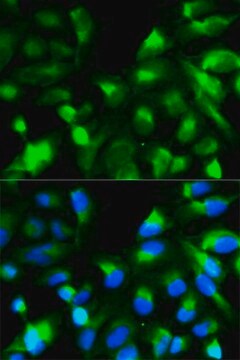S9684
Anti-SNAP-25 antibody produced in rabbit
IgG fraction of antiserum, buffered aqueous solution
About This Item
Prodotti consigliati
Origine biologica
rabbit
Livello qualitativo
Coniugato
unconjugated
Forma dell’anticorpo
IgG fraction of antiserum
Tipo di anticorpo
primary antibodies
Clone
polyclonal
Stato
buffered aqueous solution
PM
antigen 25 kDa
Reattività contro le specie
rat, mouse
Confezionamento
antibody small pack of 25 μL
tecniche
immunohistochemistry (formalin-fixed, paraffin-embedded sections): 1:5,000 using rat cerebellum sections
microarray: suitable
western blot: 1:10,000 using rat pheochromocytoma PC12 cell extract
western blot: 1:5,000 using mouse brain extract
N° accesso UniProt
Condizioni di spedizione
dry ice
Temperatura di conservazione
−20°C
modifica post-traduzionali bersaglio
unmodified
Informazioni sul gene
human ... SNAP25(6616)
mouse ... Snap25(20614)
rat ... Snap25(25012)
Descrizione generale
Anti-SNAP-25 is developed in rabbit using a synthetic peptide corresponding to the N-terminus of human SNAP-25 conjugated to KLH as immunogen. This sequence is identical in SNAP-25 alternatively spliced forms SNAP-25A and SNAP-25B, in mouse, rat and chicken SNAP-25 and highly conserved (80-85%) in goldfish and zebrafish SNAP25. Whole antiserum is fractionated and then further purified by ion-exchange chromatography to provide the IgG fraction of antiserum that is essentially free of other rabbit serum proteins. Anti-SNAP-25 recognizes mouse SNAP-25 (25 kD). The antibody cross-reacts with rat SNAP-25. Applications include the detection and localization of SNAP-25 (25 kDa) by immunoblotting and immunohistochemistry. Staining of SNAP-25 in immunoblotting is specifically inhibited with SNAP-25 immunizing peptide (SNAP-25, mouse)
Specificità
Immunogeno
Applicazioni
- the primary detection of SNAP-25
- enzyme-linked immunosorbent assay in human neuroblastoma cell lines
- immunohistochemistry
- in human neuronal cells using western blotting
Azioni biochim/fisiol
The molecular events leading to neurotransmitter release in the synaptic cleft are complex, involving multiple interacting proteins, generically termed SNAP receptors (SNAREs). It has been suggested that SNAP-25 and syntaxin on the neuronal plasma membrane (t-SNARE) and synaptobrevin/VAMP on the synaptic vesicle (v-SNARE) form a stable ternary complex. This core complex serves as a docking complex for two additional membrane fusion proteins, β-SNAP and NSF. ATP hydrolysis by NSF causes dissociation of the complex during priming of the exocytosis machinery. SNAP-25 induced reassembly and interaction with synaptotagmin (Syt), is thought to drive the Ca2+ -triggered vesicle-plasma membrane fusion and exocytosis. SNAP-25 has a key role in both developing and mature neurons. During development, SNAP-25 expression correlates with synaptogenesis, axonal growth and neuronal maturation and is found mainly in cell bodies of neonatal brain. In the adult nervous system, SNAP-25 is localized to presynaptic nerve terminals where it is conveyed by fast axonal transport.
SNAP-25 consists of two alternatively spliced isoforms SNAP-25a and SNAP-25b, differentially expressed in neurons and neuroendocrine cells. SNAP-25a and SNAP-25b differ by nine amino acids in the central domain. Two of these residues alter the relative positioning of clustered cysteine residues that are required for post-translational palmitoylation implicated in membrane anchoring, suggesting that the two SNAP-25 isoforms may play distinct roles in vesicular fusion events.
Stato fisico
Stoccaggio e stabilità
Esclusione di responsabilità
Non trovi il prodotto giusto?
Prova il nostro Motore di ricerca dei prodotti.
Codice della classe di stoccaggio
12 - Non Combustible Liquids
Classe di pericolosità dell'acqua (WGK)
nwg
Punto d’infiammabilità (°F)
Not applicable
Punto d’infiammabilità (°C)
Not applicable
Dispositivi di protezione individuale
Eyeshields, Gloves, multi-purpose combination respirator cartridge (US)
Scegli una delle versioni più recenti:
Possiedi già questo prodotto?
I documenti relativi ai prodotti acquistati recentemente sono disponibili nell’Archivio dei documenti.
I clienti hanno visto anche
Il team dei nostri ricercatori vanta grande esperienza in tutte le aree della ricerca quali Life Science, scienza dei materiali, sintesi chimica, cromatografia, discipline analitiche, ecc..
Contatta l'Assistenza Tecnica.














